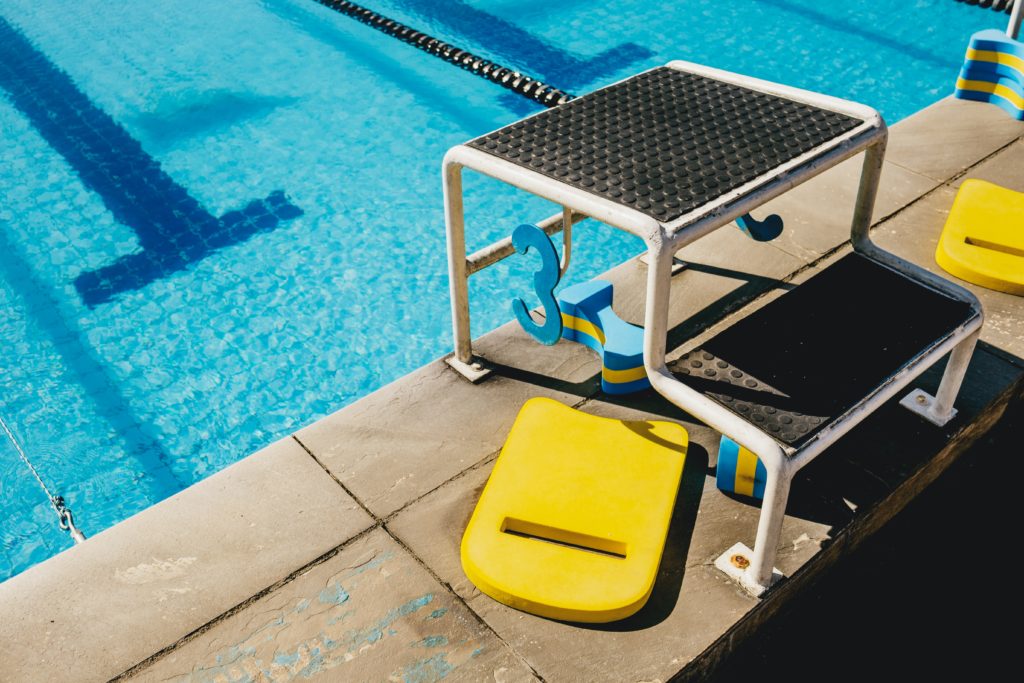Essential Swim Gear For Beginners

Triathletes love their “toys”. Whether it’s the fastest new carbon running shoes or the most aerodynamic wheels, something about the swim•bike•run life fosters an inner need to accumulate “stuff”. Some gear is necessary, a bit of it is performance enhancing, and the rest is just clutter. Of the three sports, swimming is probably the most technical, which leads people to believe they need a lot of equipment in order to get from one end of the pool to the other. However, as a new-to-the-pool athlete, you may be wondering where to spend your limited resources and when to use said equipment once you get it.
There are dozens of options when it comes to swimming training tools. The challenge is deciding what piece of swimming training equipment is right for you. These are five essential swim gear for beginners and pros alike: Swim cap, goggles, fins, paddles and a pull buoy. You can greatly improve your technique and performance by incorporating these into your weekly sessions.
Essential Swim Gear For Beginners
- A cap and goggles are necessary items in the kit bag of every swimmer. Caps keep the hair under wraps, and you’ll be wearing them in races, so you’d better get used to the feel of it. Caps can also reduce the amount of water flowing into your ears which aids in preventing the dreaded swimmer’s ear infection. Keeping the water out of your eyes (and sunlight when training and racing outside) goggles quickly become priority #1 in every swimmer’s handbook. There are some really amazing goggles that look like they’d be more at home in the cockpit of a jet fighter than on the head of a swimmer, but digital data while nice to have, isn’t mandatory. The bottom line with caps and goggles is to find a combination that is comfortable and affordable because you’ll go through several pairs throughout the season.
- The purpose of a pull buoy is to create extra buoyancy for your hips and bring your body position in line, so you are more streamlined. This can help you to focus on the rest of your stroke, build core strength, slow down your stroke to focus on form, and help with endurance for longer sessions.
- Swim paddles are used by swimmers at all levels. Most swimmers and coaches believe that using swim paddles improve stroke power and swimming strength. However, the benefit of using paddles is in improving “feel” – the ability of a swimmer to “hold on” to the water and apply pressure throughout their stroke. Generally, the LESS experienced a swimmer is, the SMALLER the swim paddle should be.
- For the feet, you’re going to want some fins. Fins come in all shapes, colors, and sizes, and many promise a range of benefits from increasing swimming speed to enhancing leg strength. The real benefit of using swim fins however is that they allow inexperienced swimmers to complete swimming drills effectively. As most swimming drills are completed at kicking speed, i.e. relying on the legs for the majority of propulsion, swim fins provide all swimmers with the opportunity to focus on their arms and their stroke technique and not be limited by their lack of kicking ability.
For reference here are other items to consider once you’ve mastered the first five:
- Performance Enhancer’s such as snorkel, band, kickboard and stretch cords
- Luxury Items such as tempo trainer, parachute, and audio-electronics.
ADVERTISEMENT

Training Equipment Concepts:
- Training equipment is meant to enhance and improve a specific aspect of your swimming. You can work on stroke and power/speed development, stroke correction and endurance improvement. Select swimming training equipment that can give you an edge or improve your skills and technique in a specific area. For example, paddles for “feel”, fins for kick.
- Training equipment isn’t a miracle cure. It is also not a short cut to boosting your swimming performance. They are a supplement to your swimming training. Think of them in the same way that vitamins and minerals are supplements to a sensible, balanced, and nutrition-rich diet.
- Avoid the “bigger is better battle”. Larger paddles for example do not mean faster swimming. Bigger fins do not mean faster kicking. Select swimming training equipment which is appropriate to you and your own unique swimming training needs.
- For beginners, try adding one piece of swimming training equipment at a time. For example, using paddles, fins and some kind of resistance device like a “parachute” can over-complicate your training. Using all the tools at once can make it difficult to determine what – if any – benefit you are actually getting.
Remember, not all swimming equipment is right for everyone. In each session aim to use at least two different pieces of gear. You don’t need to buy everything all at once and you don’t need much to get started. The important thing is that you get yourself to the pool and jump in!
ADVERTISEMENT
avant

The founder, creator and NAME behind INPYN™ Coach Elizabeth Inpyn has a long and successful career as an athlete and coach that began in the backyard pool, a three-lane, 25-yard lap pool. An NCAA Division 1 distance swimmer and water polo player, she transitioned into triathlon after college and is a multiple podium finisher at the Olympic and 70.3 race distance and a USAT National Qualifier at the Olympic distance.









